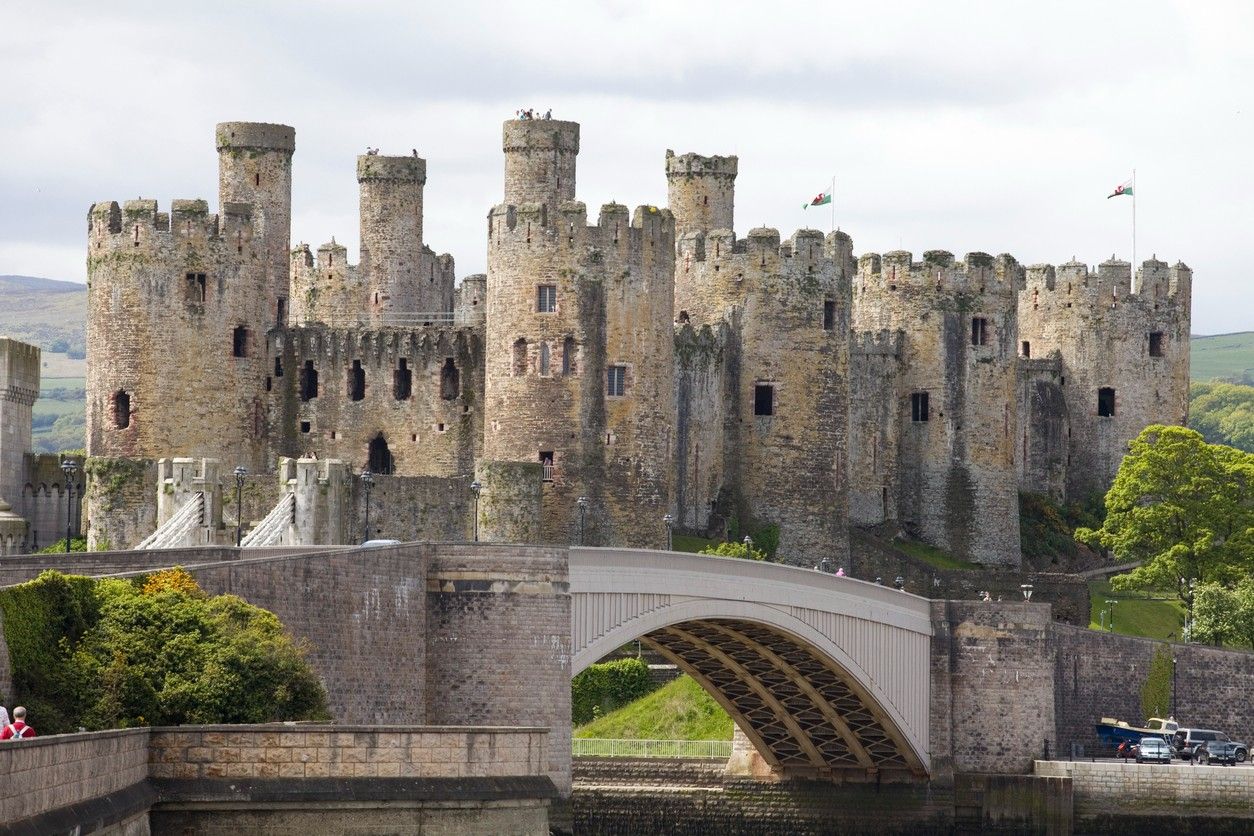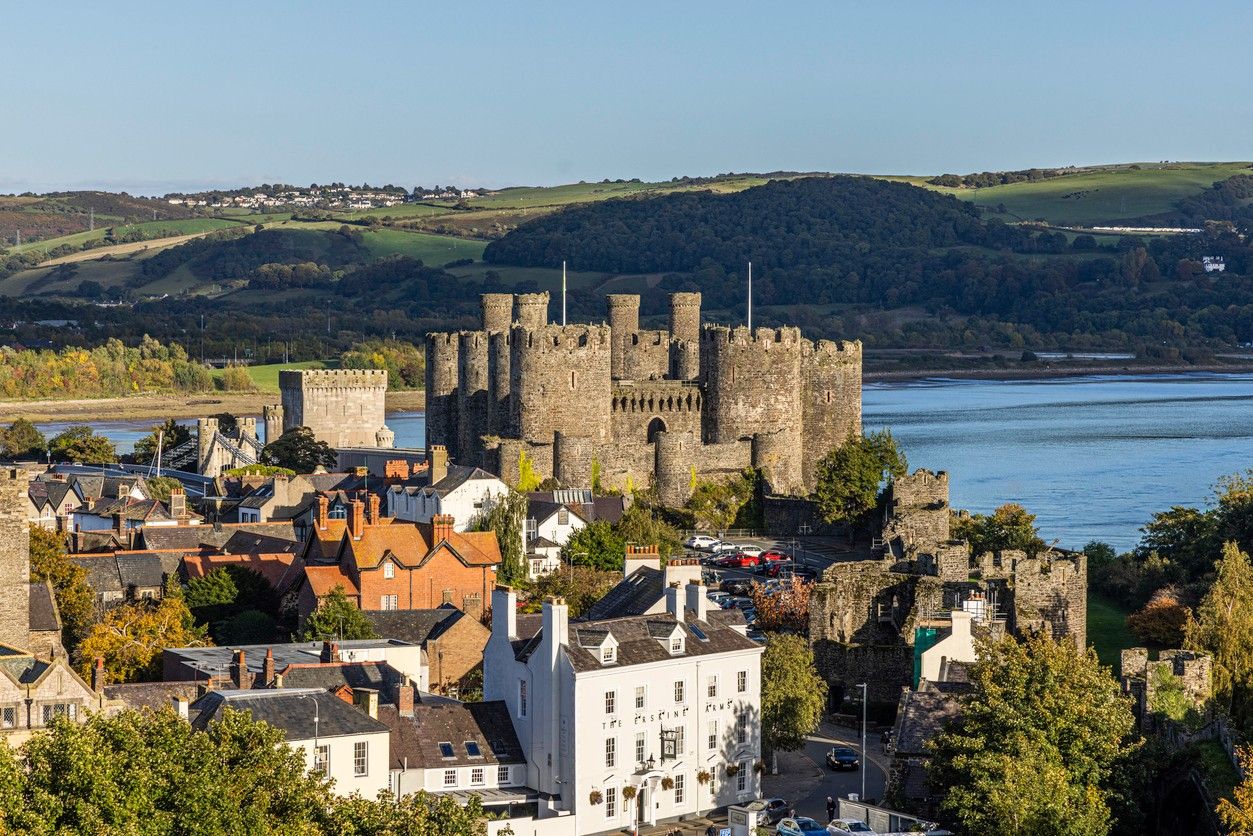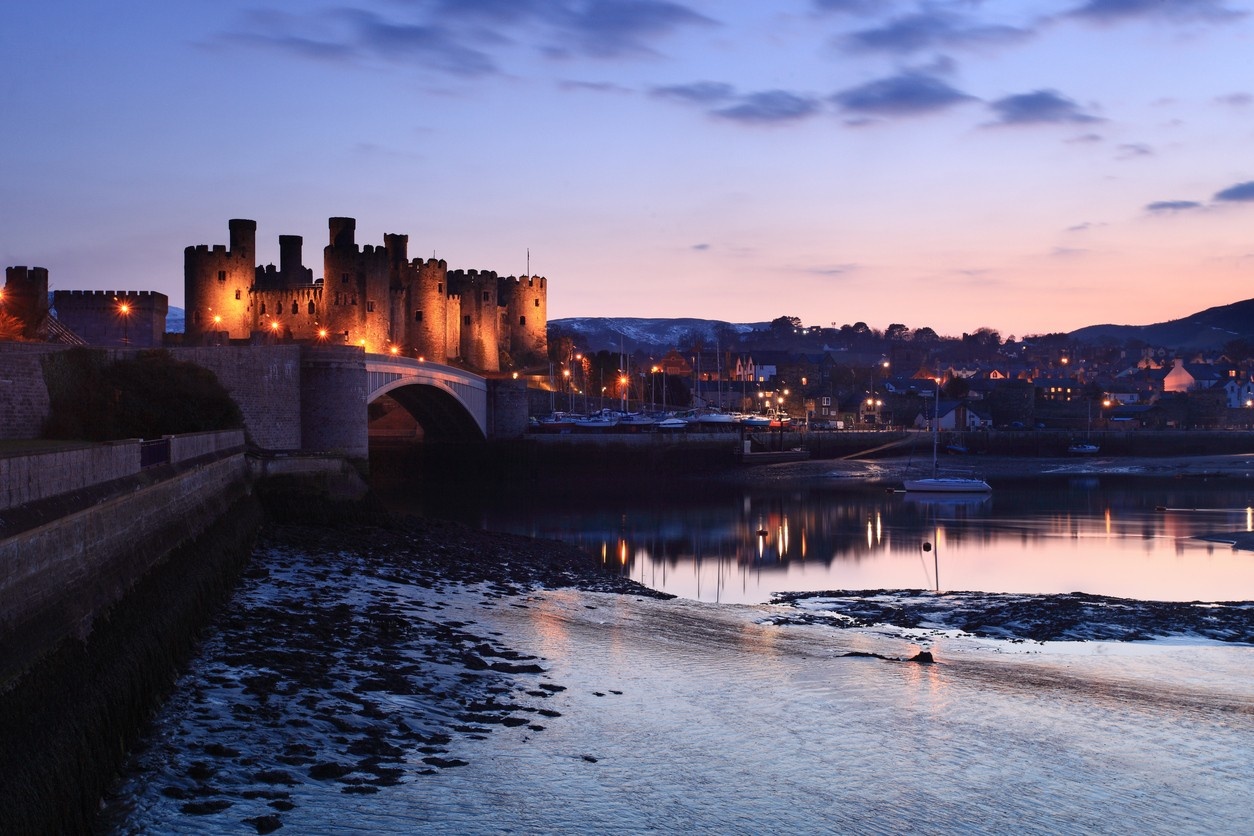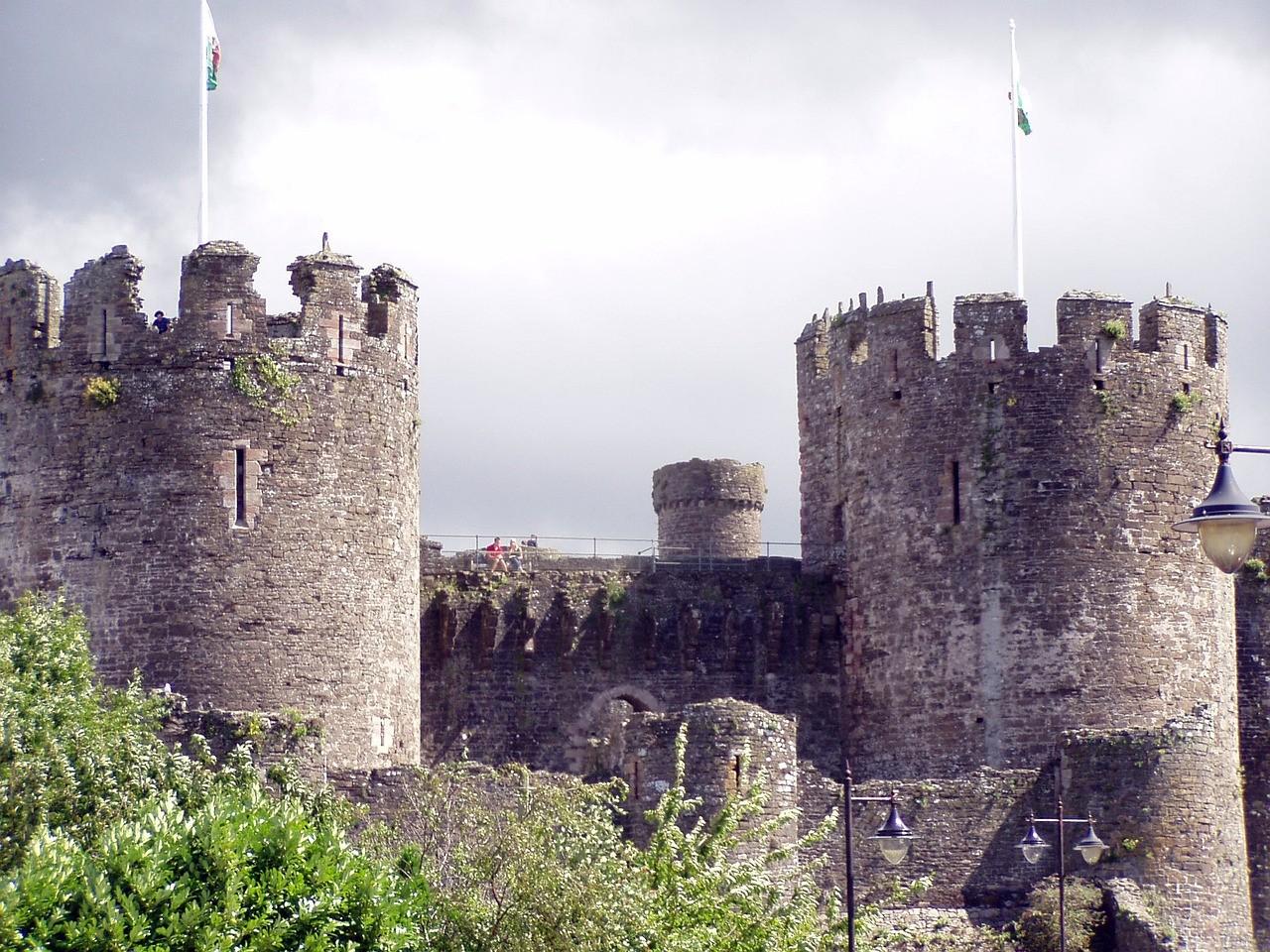Conwy Castle, a majestic 13th-century fortress nestled along the picturesque coast of North Wales, stands as a testament to the region's captivating history and architectural grandeur. Let’s delve into the castle's impressive features, its pivotal role in the conquest and rebellions of Wales, and the charming town surrounding it. The castle's awe-inspiring walls, towers, and gatehouses, showcase the engineering prowess and military might that defined its construction under the direction of renowned architect Master James of St. George. Discover more about the castle's strategic significance during the English conquest of Wales and its central role in the subsequent Welsh rebellions, learning how this fortress witnessed the region's tumultuous past.
An Architectural Masterpiece
Conwy Castle is a prime example of the impressive fortifications constructed during the reign of King Edward I. Designed by the renowned architect Master James of St. George, the castle's imposing stone walls, sturdy towers, and strategic location atop a rocky promontory have earned it a place among the most well-preserved medieval castles in Europe.
Exploring the Impressive Walls and Towers
The castle's impressive walls, which measure an average of 3 meters (10 feet) thick, were designed to withstand even the most determined siege. Constructed from sturdy local stone, these walls are a testament to the engineering prowess of the castle's designers and the skilled labour of the thousands of workers who toiled to bring this monumental fortress to life. Visitors can explore the castle's eight massive towers, each of which offers a unique perspective on the surrounding landscape and the castle's impressive defences. The towers, strategically placed along the castle's perimeter, provided vantage points for archers and served as a formidable deterrent to any would-be invaders. Climbing to the top of these towers, visitors can gaze out over the sweeping vistas of the River Conwy and the distant hills, truly appreciating the castle's impregnable position. One of the most remarkable features of the castle's towers is the attention to detail and craftsmanship that can be seen in their construction. The intricate carvings, arched windows, and robust buttresses all speak to the skill and expertise of the castle's builders, who left an indelible mark on the structure's enduring grandeur. As visitors ascend the spiral staircases within the towers, they can almost feel the weight of history and the echoes of the past, transporting them back to a time when these walls stood as an imposing symbol of English power and Welsh resistance.
The Mighty East and West Gatehouses
One of the most striking features of Conwy Castle is its imposing East and West Gatehouses. These fortified entrances, each featuring a pair of towers, were built to provide a formidable barrier to any would-be invaders, ensuring that the castle's defenders could repel attacks from multiple angles. The East Gatehouse, with its towering twin towers and sturdy portcullis, is a particularly impressive sight. Visitors can climb the spiral staircases within the towers, marvelling at the intricate architectural details and the panoramic views that stretch out across the surrounding countryside. From these elevated vantage points, it's easy to imagine the castle's former inhabitants peering out over the landscape, vigilantly guarding against any potential threats.
Similarly, the West Gatehouse, with its imposing structure and well-preserved defences, offers visitors a glimpse into the castle's strategic importance. The gatehouse's towers, equipped with arrow slits and murder holes, would have rained down a deadly hail of arrows and projectiles upon any approaching enemy. Visitors can explore the various chambers and passageways within the gatehouse, gaining a deeper understanding of the castle's complex system of fortifications. The gatehouses' sheer size and architectural sophistication are a testament to the skill and vision of the castle's designers. These impressive structures were not merely functional, but also served as symbols of power and prestige, showcasing the might of the English crown and the determination of its Welsh subjects to defend their lands.
The Castle's Interior
Beyond the castle's imposing exterior, visitors can explore the impressive interior spaces of Conwy Castle, which offer a glimpse into its former inhabitants' daily lives and activities. One of the most striking features of the castle's interior is the Great Hall, which once served as the centre of social and political life within the fortress. This expansive space, with its high ceilings, large fireplaces, and intricate stone carvings, would have been a hub of activity, hosting feasts, banquets, and important council meetings. Visitors can imagine the echoes of laughter, conversation, and the clinking of glasses as they wander through this grand hall, picturing the castle in its heyday. The castle's private chambers, tucked away within the towers and along the walls, provide a more intimate glimpse into the lives of its former residents. These spaces, ranging from the luxurious quarters of the lord and lady to the more modest accommodations of the castle's servants, offer a fascinating insight into the social hierarchy and daily routines of medieval life. Another highlight of the castle's interior is the chapel, a sacred space that would have been a crucial part of the daily life of the castle's inhabitants.
Visitors can marvel at the intricate stone carvings and the stained-glass windows that once bathed the chapel in a warm, ethereal light, creating a sense of reverence and solemnity. The castle's kitchens, with their large fireplaces and robust construction, serve as a reminder of the logistical challenges of feeding and caring for the castle's residents. Visitors can imagine the bustle of activity, the sizzle of meat on the spit, and the aroma of freshly baked bread wafting through the castle's halls. Throughout the castle's interior, visitors can find a wealth of architectural details and historical artefacts that bring the building's past to life. From the ornate door frames to the well-preserved wall paintings, each element of the castle's design and decoration tells a story, inviting visitors to step back in time and imagine the lives and experiences of those who once called this fortress home.
The Historic Significance of Conwy Castle
Conwy Castle has played a pivotal role in the history of Wales, serving as a strategic stronghold and a symbol of English power during the region's turbulent past. From its construction in the late 13th century to its role in the Welsh rebellions of the 14th and 15th centuries, this castle has borne witness to some of the most significant events in Welsh history.
The Castle's Construction and the Conquest of Wales
Conwy Castle was commissioned by King Edward I as part of his campaign to subdue the Welsh people and solidify English control over the region. The castle's construction, which began in 1283, was a massive undertaking that involved the labour of thousands of workers and the expertise of some of the most skilled architects and engineers of the time. The decision to build Conwy Castle was a strategic one, as the castle's location on a rocky promontory overlooking the River Conwy provided a commanding view of the surrounding countryside and a formidable defence against any potential attacks. The castle's impressive walls, towers, and gatehouses were designed to withstand even the most determined siege, with the castle's builders employing cutting-edge engineering techniques and the latest military technologies to create an impregnable fortress. The construction of Conwy Castle was a significant logistical challenge, requiring the transport of massive amounts of building materials, including limestone, sandstone, and timber, from quarries and forests located miles away. The castle's designers also had to contend with the rugged terrain and harsh climate of the region, which posed numerous obstacles to the construction process.
Despite these challenges, the builders of Conwy Castle were able to complete the fortress in a relatively short period, thanks to the vast number of workers employed on the project and the skilled oversight of the castle's architects. The finished castle was a testament to the power and ambition of King Edward I, who sought to cement his control over the Welsh people and establish a permanent English presence in the region. The castle's construction was not without its controversies, however, as the Welsh people viewed the fortress as a symbol of English oppression and a constant reminder of their subjugation. The castle's strategic location and imposing presence also made it a target for Welsh resistance, sparking a series of rebellions that would shape the course of Welsh history for centuries to come.
The Castle's Role in the Welsh Rebellions
Throughout the 14th and 15th centuries, Conwy Castle played a crucial role in the ongoing conflict between the English and the Welsh. During this period, the castle served as a stronghold for the English forces, withstanding numerous sieges and attacks by Welsh rebels, including the legendary Owain Glyndŵr. Owain Glyndŵr, a Welsh nobleman and patriot, led a major uprising against the English crown in the early 15th century, seeking to restore Welsh independence and the rightful rule of the native princes. Conwy Castle, with its formidable defences and strategic location, was a prime target for Glyndŵr's forces, who laid siege to the fortress on several occasions. The castle's defenders, led by the English constables and their loyal Welsh allies, fought fiercely to repel Glyndŵr's attacks, employing a range of tactics and technologies to maintain control of the fortress. From the castle's towers, archers rained down a deadly hail of arrows on the attacking Welsh forces, while the castle's sturdy walls and gatehouses withstood the repeated bombardment of siege engines and battering rams.
Despite the castle's impressive defences, the Welsh rebels were able to inflict significant damage on the fortress, breaching the outer walls and causing extensive destruction. The siege of Conwy Castle became a symbol of the Welsh people's determination to regain their independence and resist the encroachment of English rule. Even as Glyndŵr's rebellion ultimately failed, Conwy Castle remained a hotbed of Welsh resistance, with the castle's constables and garrison constantly on alert for further attacks. The castle's role in the Welsh rebellions cemented its place in the region's history, making it a site of immense cultural and historical significance for both the Welsh and the English.
Exploring the Surrounding Town of Conwy
Conwy Castle is not the only attraction in the area, as the town of Conwy itself offers a wealth of historic and cultural sights. From the charming streets lined with well-preserved medieval buildings to the stunning Conwy Suspension Bridge, there is much for visitors to discover in this picturesque corner of North Wales.
The Charming Town of Conwy
While Conwy Castle is undoubtedly the crown jewel of the region, the town of Conwy itself offers a wealth of historic and cultural sights that are well worth exploring. Visitors to the castle will find that the town's charming streets, lined with beautifully preserved medieval buildings, provide a delightful complement to the grandeur of the fortress. From the half-timbered houses with their intricate carvings to the imposing stone structures that once housed merchants and tradespeople, the town's buildings speak to its rich history and vibrant past. The town's bustling marketplace, with its array of local vendors and artisans, adds to the lively atmosphere, inviting visitors to immerse themselves in the rhythms of everyday life. Beyond the town's historic core, Conwy's streets are dotted with cosy cafes, lively pubs, and independent shops, providing ample opportunities for visitors to indulge in the local culture.
The Conwy Suspension Bridge
One of the town's most iconic landmarks, and a must-visit destination for any visitor to Conwy, is the Conwy Suspension Bridge. Designed by the renowned engineer Thomas Telford and completed in 1826, this impressive structure spans the River Conwy, offering breathtaking views of the castle and the surrounding countryside. The elegant suspension cables, which stretch across the river, give the bridge a sense of lightness and elegance, belying the immense engineering feat that went into its construction. The bridge's stone towers, with their intricate carvings and Gothic-inspired architecture, further enhance the structure's visual appeal, creating a harmonious blend of form and function. Crossing the Conwy Suspension Bridge is an experience in itself, as visitors are treated to unparalleled panoramic views of the town and the castle. But the Conwy Suspension Bridge is more than just a picturesque crossing; it is a symbol of the town's rich history and the ingenuity of its people. The bridge's construction was a remarkable achievement, as it required the coordination of hundreds of workers and the use of cutting-edge engineering techniques to overcome the challenges of the river's strong currents and rugged terrain.
The Town's Historic Sites
In addition to Conwy Castle, the town of Conwy boasts a wealth of other historic sites, including the Conwy Town Walls, the Plas Mawr Elizabethan Town House, and the Smallest House in Great Britain. Visitors can take a guided tour or explore these sites at their own pace, immersing themselves in the rich history of this charming Welsh town.
Conwy Town Walls — Surrounding the entire town, these well-preserved medieval walls offer stunning views of the castle and the River Conwy and can be accessed just a short walk from Conwy Castle.
Plas Mawr Elizabethan Town House — This beautifully restored 16th-century townhouse, located just a 5-minute walk from the castle, provides a glimpse into the opulent lifestyle of the town's elite during the Tudor era.
The Smallest House in Great Britain — This charming, diminutive cottage, situated along the River Conwy just a 10-minute stroll from the castle, is a quirky and whimsical attraction that delights visitors of all ages.
St Mary's Church — Dating back to the 13th century, this historic church, located just a 2-minute walk from Conwy Castle, features stunning Gothic architecture and a wealth of fascinating historical artefacts.
Bodlondeb Woods — These scenic woodland trails, accessible within a 15-minute walk from the castle, offer a peaceful respite from the town's bustling streets and a chance to immerse yourself in the natural beauty of the local landscape.
Accommodations and Dining in Conwy
For those looking to extend their stay in the Conwy area, there are a variety of accommodation options, from traditional castle hotels to cosy bed and breakfasts. The town also offers a diverse range of dining experiences, from local pubs serving classic Welsh fare to upscale restaurants showcasing the region's culinary delights.
Castle Hotel Conwy
The Castle Hotel Conwy offers a unique and unforgettable accommodation option. Located just a stone's throw away from the majestic Conwy Castle, this charming hotel provides guests with the opportunity to step back in time and experience the splendour of the castle era. Housed in a beautifully preserved 16th-century building, the Castle Hotel Conwy seamlessly blends its rich historical heritage with modern comforts and amenities. The hotel's guest rooms, each individually decorated to capture the essence of the castle's history, offer a cosy and inviting retreat. From the plush bedding and antique furnishings to the carefully curated artwork and decor, every aspect of the rooms has been designed to immerse guests in the castle's captivating ambience.
But the true highlight of the Castle Hotel Conwy is its stunning location, which affords guests unparalleled views of the castle and the surrounding countryside. Whether you're enjoying a hearty Welsh breakfast in the hotel's dining room or sipping a glass of local wine on the terrace, you'll be treated to a panoramic vista that will leave you awestruck and inspired. The hotel's attentive staff, many of whom are knowledgeable about the region's history and culture, are on hand to ensure that your stay is both comfortable and enriching. They can arrange guided tours of the castle, recommend the best local eateries, and share insider tips on the must-see attractions in the area, enhancing your overall experience.
Other Accommodation Options in Conwy
In addition to the Castle Hotel Conwy, the town offers a variety of other accommodation options, including traditional bed and breakfasts, family-run inns, and modern hotels. Visitors can choose from a range of prices and styles to suit their budget and preferences.
The Quay Hotel and Spa — Located just a 10-minute walk from Conwy Castle, this luxurious hotel offers elegant rooms and suites, as well as a full-service spa and stunning views of the River Conwy.
Gwynfryn Bed and Breakfast — This charming, family-run B&B is situated a mere 5-minute walk from the castle, providing visitors with a cosy, home-away-from-home experience and a delicious Welsh breakfast.
The Bluebell Inn — Just a 7-minute stroll from Conwy Castle, this traditional inn offers comfortable, budget-friendly accommodations, as well as a lively pub and restaurant serving up local favourites.
Bodysgallen Hall and Spa — This historic country house hotel, set within 200 acres of beautiful parkland, is located a 15-minute drive from Conwy Castle, offering guests a luxurious retreat in a peaceful, scenic setting.
The Groes Inn — Situated a 10-minute drive from the castle, this charming, family-owned inn combines the warmth of a traditional Welsh pub with well-appointed guest rooms, perfect for those seeking a more rural escape.
Ty Castell Bed and Breakfast — Located just a 3-minute walk from Conwy Castle, this elegant B&B provides visitors with a truly intimate and authentic experience, showcasing the town's rich history and culture.
Dining in Conwy
Conwy's culinary scene is as diverse as its historic attractions. Visitors can enjoy classic Welsh dishes, such as Welsh rarebit and lamb cawl, in cosy local pubs, or indulge in gourmet fare at the town's upscale restaurants. The town's proximity to the coast also means that fresh seafood is a speciality, with local eateries serving up delectable dishes featuring the catch of the day.
The Mulberry — This cosy, traditional Welsh pub, located just a 5-minute walk from Conwy Castle, serves up classic local fare, including hearty lamb cawl and Welsh rarebit, in a charming, historic setting.
The Erskine Arms — This upscale restaurant, situated a mere 2-minute walk from the castle, offers a contemporary twist on Welsh cuisine, showcasing the region's fresh seafood and locally sourced produce in a refined, elegant atmosphere.
Alfredo's Ristorante — Just a 7-minute stroll from the castle, this family-owned Italian restaurant offers a delightful respite from traditional Welsh fare, serving up authentic pizzas, pasta, and other Italian specialities in a warm and welcoming setting.
The Quay Hotel and Spa — The on-site restaurant at this luxury hotel, located a 10-minute walk from Conwy Castle, boasts stunning views of the River Conwy and a menu that highlights the finest local and seasonal ingredients.
The Fisherman's Lodge — Situated just a 12-minute walk from the castle, this cosy, casual eatery specialises in freshly caught seafood, offering visitors a chance to savour the flavours of the nearby coast in a charming, laid-back atmosphere.
The Castle Hotel Conwy — For a truly immersive dining experience, the Castle Hotel Conwy, just steps away from the castle, serves up traditional Welsh cuisine and locally sourced ingredients in a historic, castle-inspired setting.
Planning Your Visit to Conwy Castle
For those planning a visit to Conwy Castle, there are a few key tips to ensure a seamless and enjoyable experience. From purchasing tickets in advance to exploring the castle's various attractions, this section provides a comprehensive guide to help visitors make the most of their visit.
Conwy Castle Tickets — Visitors to Conwy Castle can purchase tickets on-site or online in advance. Advance ticket purchases are recommended, especially during peak seasons, to ensure entry and avoid long queues. Ticket prices vary depending on age and group size, with discounts available for students, seniors, and families.
Navigating the Castle Grounds — Once inside the castle, visitors can explore the various towers, chambers, and walkways at their own pace. Audio guides and guided tours are available to provide additional context and insights about the castle's history and architecture. Visitors should also be prepared for the steep staircases and uneven terrain, which can be challenging for those with mobility issues.
Conwy Castle as Part of a Larger Itinerary — Conwy Castle can be easily incorporated into a wider exploration of North Wales, with nearby attractions such as the Snowdonia National Park, the Llandudno Pier, and the historic town of Caernarfon offering ample opportunities for additional sightseeing and adventure.
Related Articles

Let us know you agree to cookies
We use marketing, analytical and functional cookies as well as similar technologies to give you the best experience. Third parties, including social media platforms, often place tracking cookies on our site to show you personalised adverts outside of our website.
We store your cookie preferences for two years and you can edit your preferences via ‘manage cookies’ or through the cookie policy at the bottom of every page. For more information, please see our cookie policy.









